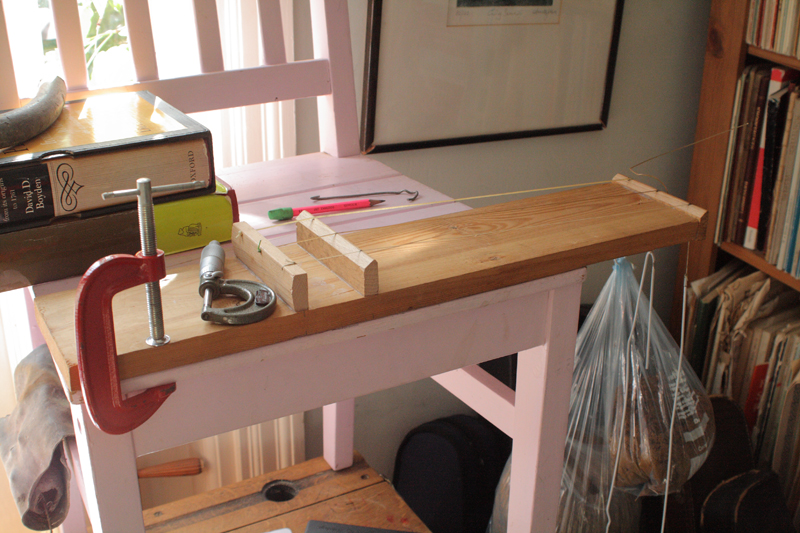An experiment with gut string tension
A very interesting module of my music degree was Acoustics, which incorporated the theories of Mersenne. It was useful to apply my knowledge of the relationship between string mass, length and tension when, as a young professional in London, I discovered that I had a choice of gauges when buying modern strings. I suspected that my D-string was a bit tight, so tried one of the thinner gauges offered, was satisfied with the result, and started to make a note of the gauges for each string.When I picked up a copy of Spohr's Violin School a few years later I was interested to see that my practice matched his advice: experiment to learn what suits you, what feels right, and stick to it. The only difference was that he was using three plain gut strings, of varying numbers of strands of gut, and was measuring diameters with a simple calibrated tapering slot in a small metal plate. No micrometers and factory precision in 1830.
In recent years, and with the rise of interest in period performance, there has been much interest in the theories of "equal tension", "scaled tension" and how to reproduce the conditions and practices of earler times. Oliver Webber and Mimmo Peruffo have done much work in this field. Their conclusions are significantly different, and lead to confusion for many players. Over the years I have tried different gauges for period work, and have settled on setups that feel right to me - a perfectly good authentic approach - but I have been puzzled for some time by the discrepancies between Ollie and Mimmo, and have felt driven to conduct my own experiments. At last, in June 2015 I did so, along the lines described by di Colco and Leopold Mozart.
I used bags of sand, kitchen scales, a micrometer and a purpose-built frame on which the strings were stretched, lubricating the "nut" and "bridge" with graphite so that the strings travelled smoothly as they stretched. Below is displayed a table of the data I collected. Pitches indicated are pretty accurate; any that were a bit out of tune with the piano (A=440) I rounded up or down on the tables - only a small and insignificant adjustment to the weight would have been necessary to pitch the string accurately. What the data clearly shows is that the "equal tension" set-up - as recommended on the Monteverdi Violins historical stringing page and in Ollie's publication "Rethinking Gut Strings: a Guide for Players of Baroque Instruments" - which is the first set of results, is far from equal (yellow highlights).
I think I understand what has happened. The appendix of "Rethinking Gut Strings" tells us that the "authentic" stringing dimensions were calculated using the Mersenne-Taylor formula. However, I can't help concluding that there is a fundamental error here:
the assumption (p. 22) that "The density is the mass per unit volume of the string: since we are dealing (mostly) in all gut, this remains the same and can be ignored"
That is the flaw! It doesn't remain the same. It doesn't matter if it is pure gut or a single strand of metal, or a composite of purlon, nylon, silk, silver winding .... the dimension of the string as shown on the packet is irrelevant because, as you stretch it, part of the working mass is transferred across the nut, and the working mass reduces, so you must apply the formula to the E-string once it has reached the desired pitch, and has thinned significantly.
At first the tensions were so unequal that I thought there might have been an error, so I retested with another string - this time an 88 gauge string - the results are at the bottom of the tables (light blue highlights). These results appear to support Mimmo's conclusions pretty convincingly - it is easy to see how the E-string thins so much in comparison with the others as the tension increases.
I can confidently extrapolate from the figures that an A-string of about 78 will create more-or-less equal tension alongside an E-string of 58. (The light grey highlighted figures approach this.) And that is pretty much equivalent to the set-up that is deprecated as not historically accurate in "Rethinking Gut Strings: a Guide for Players of Baroque Instruments".
Or maybe we should just play with what feels right? Any half decent string player is sensitive to the response of each string, will perceive if one string is relatively slack or tight, and will learn to adopt a set-up that feels consistently responsive, and suits the player's touch. That is the "authentic" way, whether you are a plucker of the lute in 17th century Venice, a prog rock bass guitarist in the Camden Barfly, or a scraper of a fiddle in the Royal Albert Hall or the local pub folk club. Have a look at this discussion in a guitar forum. Mozart and di Colco, in that age of scientific discovery and enlightenment, were just demonstrating, through science, the relationships between length, mass and tension! The anomaly in the di Colco drawing suggests that the experiment was hypothetical - the suspended weights are depicted at equal height, when, in practice, they hang at different heights as the thinner string stretches more, as demonstrated by Mimmo on pp 18 and 19 of his pamphlet. And di Colco displays no device that counterbalances the weights!
Dan Larson, of Gamut strings, believes that Mersenne suggests somewhere that, in spite of the beauty of the theory of string relationships, players tend to do what suits them.
Dmitry Badiarov has some very well-considered thoughts on the subject
Miles Golding, August, 2015 (updated 4 February 2016)




